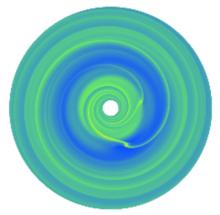HD 45364
| Observation data Epoch J2000.0 Equinox J2000.0 | |
|---|---|
| Constellation | Canis Major |
| Right ascension | 06h 25m 38.48s[1] |
| Declination | −31° 28′ 51.4″[1] |
| Apparent magnitude (V) | 8.07 |
| Characteristics | |
| Spectral type | G8V |
| B−V color index | 0.719 |
| V−R color index | 0.01 |
| Astrometry | |
| Radial velocity (Rv) | 15.9 km/s |
| Proper motion (μ) | RA: 53.22 ± 0.48 [1] mas/yr Dec.: −13.20 ± 0.77 [1] mas/yr |
| Parallax (π) | 30.59 ± 0.68[1] mas |
| Distance | 107 ± 2 ly (32.7 ± 0.7 pc) |
| Absolute magnitude (MV) | +5.50 |
| Details | |
| Mass | 0.88 ± 0.02[2] M☉ |
| Radius | 0.82 ± 0.01[2] R☉ |
| Luminosity | 0.562 ± 0.004[2] L☉ |
| Surface gravity (log g) | 4.55 ± 0.03[2] cgs |
| Temperature | 5540 ± 31[2] K |
| Age | 3.4 ± 2.7[2] Gyr |
| Other designations | |
| Database references | |
| SIMBAD | data |
| Exoplanet Archive | data |
| Extrasolar Planets Encyclopaedia | data |
HD 45364 is a star approximately 107 light years away from Earth in the constellation of Canis Major. As of August 2008 there are two confirmed extrasolar planets orbiting around it.[3]
Planetary system
HD 45364 is one of only a relative few systems that have had more than one exoplanet discovered in its orbit. The two planets, HD 45364 b and HD 45364 c respectively, were both discovered in August 2008.
| Companion (in order from star) |
Mass | Semimajor axis (AU) |
Orbital period (days) |
Eccentricity | Inclination | Radius |
|---|---|---|---|---|---|---|
| b | ≥0.1872 MJ | 0.6813 | 226.93 ± 0.37 | 0.1684 ± 0.190 | — | — |
| c | ≥0.6579 MJ | 0.8972 | 342.85 ± 0.28 | 0.0974 ± 0.012 | — | — |
Formation scenario

A detailed analysis of the formation scenario revealed that the previously reported orbital configuration might not be correct.[4] The eccentricities are a factor of 4-5 too large to be consistent with standard planet formation theories. This is the first time that planet formation theory was able to predict new orbital parameters of a planetary system. There are other proposed scenario, in which remains the resonant configuration of the planetary system [5]
References
- 1 2 3 4 5 van Leeuwen, F. (2007). "Validation of the new Hipparcos reduction". Astronomy and Astrophysics. 474 (2): 653–664. Bibcode:2007A&A...474..653V. arXiv:0708.1752
 . doi:10.1051/0004-6361:20078357.Vizier catalog entry
. doi:10.1051/0004-6361:20078357.Vizier catalog entry - 1 2 3 4 5 6 Bonfanti, A.; et al. (2015). "Revising the ages of planet-hosting stars". Astronomy and Astrophysics. 575. A18. Bibcode:2015A&A...575A..18B. arXiv:1411.4302
 . doi:10.1051/0004-6361/201424951.
. doi:10.1051/0004-6361/201424951. - 1 2 Correia, A. C. M.; et al. (2009). "The HARPS search for southern extra-solar planets XVI. HD 45364, a pair of planets in a 3:2 mean motion resonance". Astronomy and Astrophysics. 496 (2): 521–526. Bibcode:2009A&A...496..521C. arXiv:0902.0597
 . doi:10.1051/0004-6361:200810774.
. doi:10.1051/0004-6361:200810774. - ↑ Rein; et al. (2010). "The dynamical origin of the multi-planetary system HD 45364" (abstract). Astronomy and Astrophysics. 510 (1). Bibcode:2010A&A...510A...4R. arXiv:0910.5082
 . doi:10.1051/0004-6361/200913208. (web preprint)
. doi:10.1051/0004-6361/200913208. (web preprint) - ↑ Correa-Otto, J. (2013). "A new scenario for the origin of the 3/2 resonant system HD 45364". Astronomy and Astrophysics. 560 (65): 1–10. Bibcode:2013A&A...560A..65C. arXiv:1307.1822
 . doi:10.1051/0004-6361/201321917.
. doi:10.1051/0004-6361/201321917.
Coordinates: ![]() 06h 25m 38s, −31° 28′ 51″
06h 25m 38s, −31° 28′ 51″